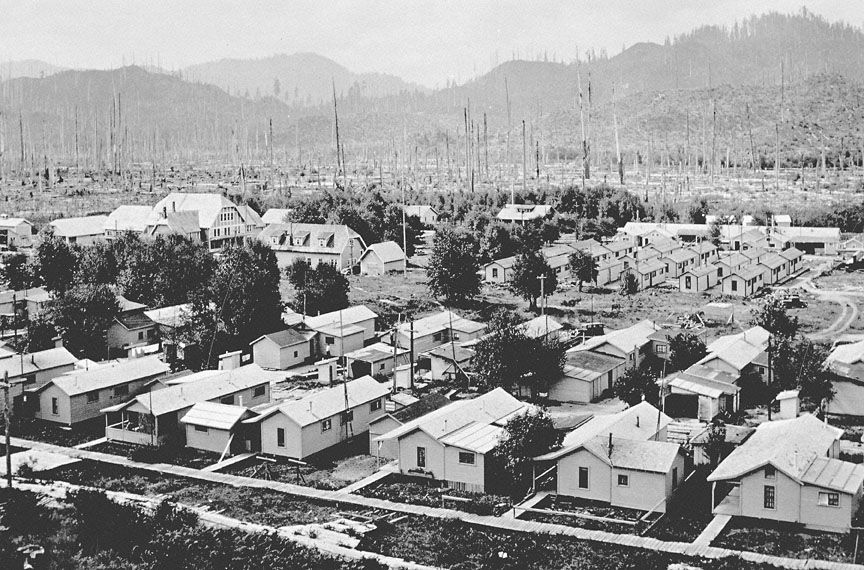This panoramic photograph of 1928 depicts a portion of Valsetz, a company-owned logging and sawmill town in the Coast Range mountains west of Salem.
Timber harvesting gradually spread into forests that were farther and farther from the waterways and railroads where mills were located. The timber industry responded with new logging methods and new timber-oriented communities. After fire struck a large stand of timber in the Coast Range in 1910, the William W. Mitchell Company built a railroad west from the small farming town of Independence to speed the harvest of the damaged trees. In the first few miles, the railroad threaded Kings Valley of the Luckiamute River, an area dotted with farms that dated from the 1840s. Thirty-nine miles from Independence, on the flats where Fanno Creek joined the South Fork Siletz River and just over the crest of the mountains, the company began to build a sawmill and a company town in 1919.
The railroad was called the Valley & Siletz, and it was apparently the inspiration for the name of the town, which was established with the opening of a post office named Valsetz on November 6, 1920. The photograph shows the residential area in the foreground with its plain and modest houses for loggers and mill workers who have families. In the background are the small dormitories that housed unmarried men. The headquarters and store of the lumber company—now Cobbs & Mitchell—can be seen at the left. Designed in a Tudor revival style that was popular in the 1920s, it has jerkinhead roofs and simulated half-timbering. The ravages of both a forest fire and of recent logging are visible in the background.
The company town was an alternative to the traveling logging camp, and represented a response to changing labor conditions and timber worker complaints about living conditions. As the labor force shifted from single transient workers to one that was increasingly married and stable, the woods camp was replaced by town living, with “commutes” by train into the woods. Valsetz offered the basics of town life, but like many closed communities it was isolated and closely controlled by the company. With the depletion of available timber, the Valley & Siletz Railroad was abandoned in the 1970s. The Boise Cascade Corporation, which then owned the properties, closed all operations in Valsetz in1984 and removed every building. The former townsite is now part of a tree farm.
Further Reading:
Hobson, Dorothy Anne, and Ron Fowler. The Valsetz Star: 2000. Steilacoom, Wash., 2000.
Erickson, Kenneth A. Lumber Ghosts: a Travel Guide to the Historic Lumber Towns of the Pacific Northwest. Boulder, Colo., 1994.
Written by Richard Engeman, © Oregon Historical Society, 2005.
